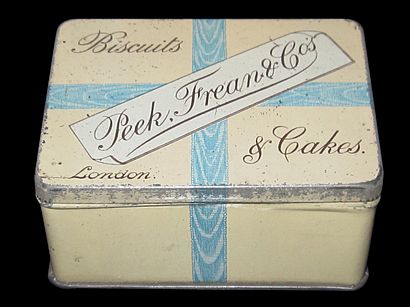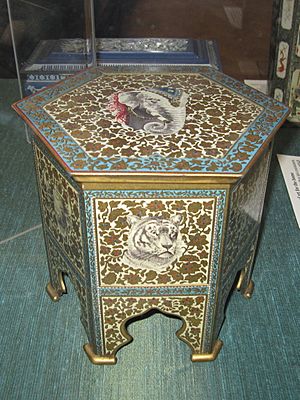Biscuit tin facts for kids


Biscuit tins are special containers that hold and sell biscuits and some candies. You often see them in homes in Great Britain, Ireland, and countries that are part of the Commonwealth. They also became popular in other parts of Europe and Canada. More than 60% of homes in the UK have a biscuit tin!
Sometimes, these tins look so nice that charities and tourist spots use them to raise money. People are often happy to pay a bit more for biscuits if they come in a beautiful tin.
Contents
History of Biscuit Tins
Biscuit tins are made from steel cans that have a thin layer of tin on them. This material is called tin plate. Around 1850, Great Britain became the main supplier of tin plate worldwide. This was thanks to new inventions and control over tin mines. Making biscuit tins was a small but important part of this huge industry. The demand for tin plate grew a lot in the 1800s because food production was becoming more industrialized. This meant new ways to preserve and distribute food were needed.
The British biscuit tin became popular after the Licensed Grocer's Act in 1861. This law allowed groceries to be packaged and sold individually. At the same time, it became cheaper to print labels directly onto tin. A new printing method called offset lithography, invented in 1877, made it possible to print colorful designs on tins of all shapes.

The idea of a decorated biscuit tin started with Huntley & Palmers in 1831. In 1868, Huntley & Palmers asked a company called De La Rue to create a special decorated tin. Early ways of printing involved transferring designs, like on porcelain or pottery. Another method was direct lithographic printing, where an inked stone was pressed onto the tin. The problem with this was that it was hard to get the colors in the right place.
The big change for decorated tins was the invention of offset lithography. This method uses a sheet of rubber to pick up the design from a stone, then press it onto the metal. This meant many colors could be used and placed perfectly, even on bumpy surfaces. This is how the fancy, colorful, and embossed (raised) designs on late Victorian biscuit tins became possible.
The most exciting designs were made in the early 1900s, before the First World War. In the 1920s and 1930s, making these tins became more expensive. So, the designs became simpler, except for tins made for Christmas. These Christmas tins were often designed to appeal to children. Overall, the designs usually showed what was popular at the time.
When the Second World War started, decorative tin production stopped. After the war ended in 1945, these fancy tins were not as popular as before.
Today, old biscuit tins are often found in museums and are collected by people who enjoy vintage items.
Tins as Home Decorations
Biscuit tins were always more than just containers. The companies wanted to make products that people would keep and enjoy even after the biscuits were gone.
Tins shaped like real objects started appearing in the late 1890s. At first, they looked like baskets. But soon, they were shaped like all sorts of beautiful art pieces. Biscuit tins were no longer just for children at Christmas. They became useful and pretty items in middle-class homes.
For example, tins shaped like Chinese vases could actually be used as vases once the biscuits were eaten. Other boxes looked like fine porcelain, Wedgwood china, or fancy wooden boxes. They copied the beautiful objects found in grand houses or museums.
The First World War caused a break in the supply of decorated biscuit tins. Many companies were unsure about making "fancy" tins again after the war. However, children really liked these well-designed, unusually shaped tins. Their interest helped make sure these special tins continued to be made.
Shop Biscuit Tins
British biscuit makers used to send biscuits to grocery shops in large tins. These tins usually held about 3.2 kilograms (7 pounds) of biscuits. The shops would display these big tins. When a customer wanted biscuits, the shopkeeper would weigh out the amount they wanted into a paper bag. Some of these large tins even had a glass panel in the lid. This way, customers could see the biscuits inside before buying them.
Images for kids
-
A cool Huntley & Palmers biscuit tin
-
A Peek Freans biscuit tin
-
A "Kashmir" biscuit tin shaped like a small Indian table, made by Huntley & Palmers in 1904
See also
 In Spanish: Tarro de galletas para niños
In Spanish: Tarro de galletas para niños






